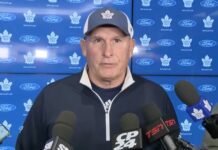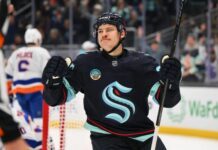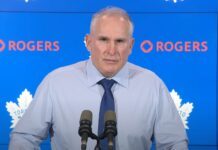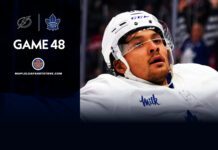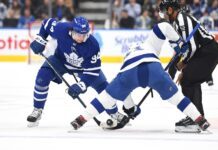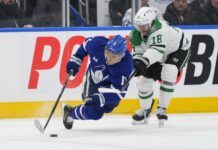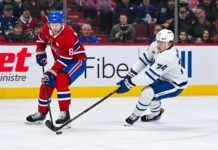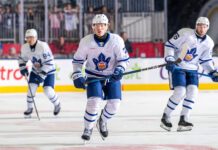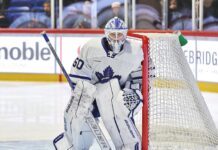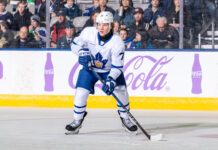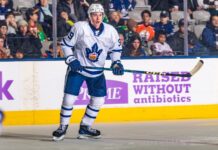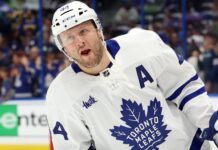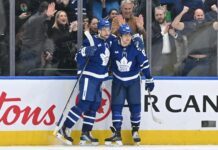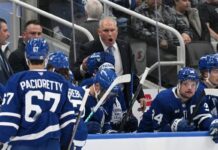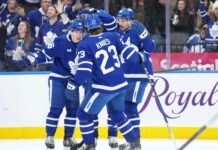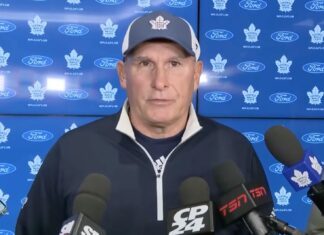After a late flurry of offseason moves—Nick Robertson’s contract, Max Pacioretty and Steven Lorentz’s PTOs—and with a collection of young players knocking on the door this exhibition season, there is one early question I keep returning to with this Maple Leafs team: What does their ideal forward lineup look like?
If you asked me seven days in a row, you might get seven different answers. Even with William Nylander at center – where the juice is worth the squeeze if it pans out – there is much to sort through, good and bad.
The Leafs have 13 NHL forwards under contract right now. They all played on the team last season and contributed positively at various points. The group collectively finished second in the NHL in goals and has enough youth and room for internal improvement to offset losing Tyler Bertuzzi’s 21 goals and any potential dropoff from Auston Matthews’ ridiculous 69-goal season.
Additionally, there is Pacioretty, who Elliotte Friedman has implied will almost surely sign a contract with the Leafs before opening night. Lorentz was a semi-regular on a Cup champion last season, which, on the one hand, wouldn’t frame him as an AHL option to be called upon later. On the other hand, Lorentz is not particularly productive, so that pathway for him could feasibly play out.
And then there are the young players knocking on the door. Easton Cowan doesn’t have much, if anything, left to do in the OHL. If he could go to the AHL, there probably wouldn’t be much discussion, but it’s not an option this fall. Nikita Grebenkin offers an interesting skill set, but he should almost certainly start in the AHL to help him adjust to the North American pro game. The same goes for Fraser Minten, who isn’t an option right now anyway, due to a high-ankle sprain. The above two players are potentially interesting mid-season call-ups who could stick at some point later this season, but they aren’t ready right now.
That leaves 15 NHL forwards and Cowan vying for 13 NHL spots—possibly 14 if management can clear cap space or if there is an injury situation. Overall, this is a good problem—there are too many options and insufficient roster spots to fit all of them, with legitimate NHL depth and a sprinkling of youth in the mix.
Optimizing the 12 best forwards, though, is a different question altogether. When I try to put it together, something always looks a little off.
Currently, they are set up to line up roughly like so:
Knies – Matthews – Marner
Domi – Nylander – Jarnkrok
McMann – Tavares – Pacioretty/Robertson
Dewar – Kampf/Holmberg – Reaves
Even if we were to assume Nylander can capably move to center – and I think he can, but it will take time – the idea of pairing him with Max Domi doesn’t make much sense. When the two lined up together last season, they were thoroughly outplayed. In 190 5v5 minutes together, they controlled just 42.36 percent of shot attempts and 42.43 percent of expected goals. They were outscored 13-12 overall despite a near 65 percent offensive-zone faceoff percentage.
Numbers aside, it doesn’t take long to see that Nylander and Domi are far and away the two most passive defensive forwards on the team. Once the puck was in their own zone last season, they couldn’t get it out, and I don’t think moving Nylander to the middle is going to fix that problem, nor can Calle Jarnkrok drive them defensively on his own (although it would be worthy of a Selke nomination if he did).
The team’s potential third line in this scenario is not exactly going to pick up tough defensive minutes and make their lives easier, either, to say nothing of a fourth line with Ryan Reaves on it that cost them a bunch of goals in the playoffs.
The Knies – Matthews – Marner trio seems to be a foregone conclusion, but it’s worthy of discussion. In a year when Matthews produced the greatest goal-scoring season in decades and Marner produced at a 1.23 points-per-game clip, Knies recorded just 35 points while largely riding shotgun alongside them. While he adds something with his size and is skilled enough to play alongside them, I’m not sure Knies makes Matthews-Marner demonstrably better or that they make Knies better.
Knies’ best games were away from Matthews and Marner, including in the playoffs when he played with Tavares and Nylander and blossomed into a difference-maker. Not to mention, if the Leafs are going to pair up two of the highest-paid players in the league (a great regular season duo), do they also need to play with the team’s best left winger? The duo had a good stretch last season with Pontus Holmberg as their left winger. Matthews was unfazed when Bertuzzi and Domi were his linemates, but now he’s taking their best left and right winger, causing a negative domino effect for the rest of the lineup.
The general approach of spreading talent over three lines and building up the middle with Matthews-Nylander-Tavares is a welcome experiment. The potential payoff is worth any growing pains. We know with certainty that the Leafs’ “two first lines plan” did not work. Watching the coaching staff pair up Matthews-Marner/Tavares-Nylander and believe they have the top two lines to create a “pick your poison” matchup problem – one capable of blitzing through the opposition – clearly hasn’t worked at playoff time.
Now, Leafs brass is attempting to spread it out across three lines, but in the process, at least one line looks a little out of place – it’s either not good enough defensively, a player is playing too far up or down the lineup, or someone is in the wrong position altogether.
Our initial look at building lines around that core structure down the middle (Matthews-Nylander-Tavares) leaves a lot to be desired for me. It will be an ongoing process to figure out who slots in with whom and how to build around this center group, and that’s before we consider any salary cap implications. Depending on how some training camp storylines play out – Will Nick Robertson take a step forward? Can Max Pacioretty be a healthy, consistent performer? – the forward group might not fully come together until they add outside help before the trade deadline.
The Leafs have more than enough depth and talent to be good in the meantime, but I don’t think they are close to properly optimizing this group with pieces that fit together in a beneficial configuration for the overall team.
Other Notes on Maple Leafs Camp and Preseason
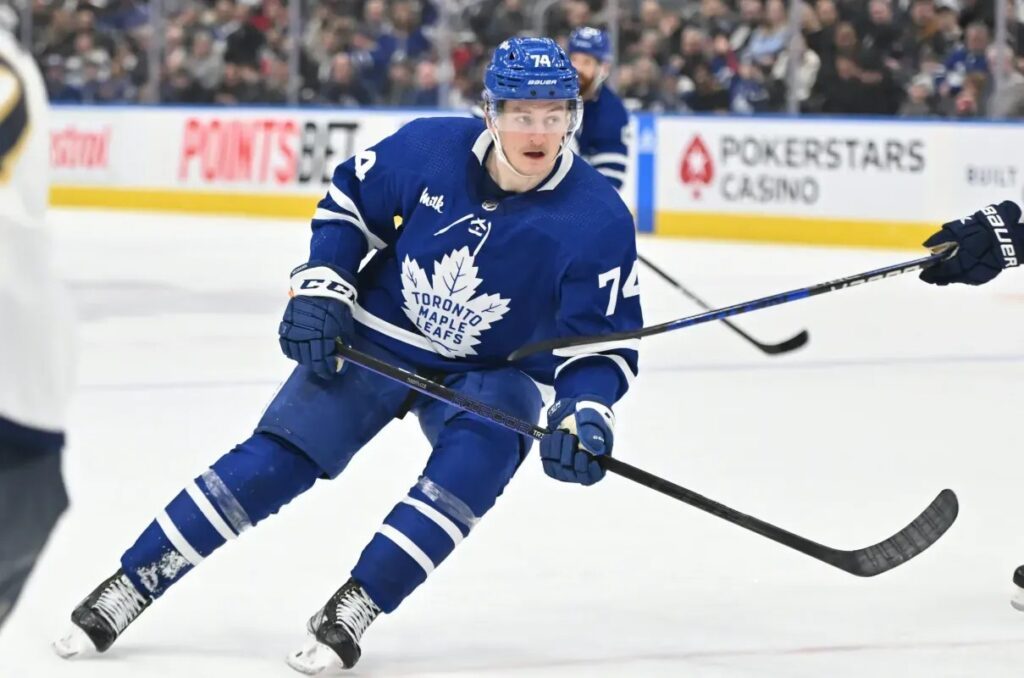
– Craig Berube told the Toronto Sun that he’s looking for an “identity” third line. I think that Bobby McMann and John Tavares, as part of said line, is a good start. The other winger is to be determined (Max Pacioretty? Nick Robertson? Someone else?), but the Tavares-McMann pairing was very good last season, whether Robertson or Nylander was the other winger. The question for me: Can they afford to place McMann on the third line? I’m not sure the team has four wingers better than him.
McMann produced a really strong preseason debut in Ottawa, and his speed and strength should also make him a good penalty-killing option this season (he flashed potential shorthanded last season and looked good there in his first exhibition game). He’s a strong forechecker who plays the north-south style of hockey that Berube preaches.
– You almost have to remind yourself that Cade Webber is 6’7, which is both good and bad.
The good: He is fluid and reasonable with the puck, considering his size. But he’s also light relative to his height. Webber is listed at 212 pounds right now. For reference, Morgan Rielly is 13 pounds heavier despite standing a half-foot shorter. That’s why Webber isn’t a particularly physically imposing player, even though he’d be one of the biggest players in the NHL.
Tall people tend to take time to grow into their bodies and fill out – Webber seems to be in this stage of his physical development – but I was impressed with his coordination and ability to move around the ice. If he fills into his body and keeps up his (relatively) smooth skating, he should find his way into the NHL at some point, given his size.
– There’s always talk when players don’t choose Toronto – e.g., Jeff Skinner signing with the Oilers – but it’s worth noting that Max Pacioretty chose a PTO with the Leafs over an NHL contract elsewhere. Alex Nylander also received better offers than Toronto’s AHL contract (he likely chose the Leafs partly because of his brother, but we’ve seen brothers not reunite here before, such as Trevor Van Riemsdyk). Chris Tanev wanted to come home. Like every team, they can’t recruit every player in the league, but the Leafs don’t have an issue attracting talent.
– I understand why the Leafs’ coaching staff elected to reunite the team’s top power-play unit out of the gate. Over the last five seasons combined, they are third in the NHL in power-play efficiency. This is a massive sample size of elite production.
However, it caught my eye when Berube said, “I know you are going to bring up the playoffs last year. Well, you can go into dry spells. It happens to every team. It was just the wrong time for them, but that is a very good power-play unit.”
The thing is, it’s not just last season. It falls off a cliff every playoff except the one spring the team won a round. Over those five seasons, their playoff power play percentage is 15.4 percent – a full nine percent drop from their regular season production. Maybe they think they can change something else to get it over the hump other than the personnel, but he is kidding himself if he thinks the last playoffs was just an inopportune dry spell.
– It also caught my eye when Brad Treliving said, “Internal growth is the best way to get better, not flying in the great free agent or making 10 trades.” I am curious to see how he balances it as the Leafs have one pick in the first four rounds of the upcoming draft (the Panthers’ second-rounder), they have two players on PTOs they would likely need to make room for, and their easiest players to move out are young (Holmberg and Robertson).
I’d rather Treliving go the development route, keep Robertson and Holmberg, start Minten and Grebenkin in the AHL, move Knies around the lineup to squeeze more out of him, settle Connor Dewar into the lineup as an energy guy/penalty killer, and see how it shakes out by January. Even though he’s not that young, I’d include McMann in the “internal growth” group. This will be his first full NHL season, and I think there’s something there. He’s a player.
– It’s important to remember that late first-round draft picks generally don’t make the NHL full-time out of camp just one year removed from their draft. This territory is usually reserved for high lottery picks. That said, Easton Cowan produced a great preseason last fall, followed by an incredible season in London. It’s just two preseason games, but he hasn’t made the Leafs’ lives particularly difficult so far and is already in Group 2 in training camp, which is primarily composed of players who won’t be making the team. It would be a little disappointing, but it’s better not to rush him.
– That was a nice start to preseason for Pontus Holmberg. Last year, he had a really poor preseason and didn’t make the team. It was a disappointing showing following a promising rookie campaign. He came into this camp and weighed in at 201, a whopping 13 pounds heavier than last season. He looks strong and heavy, which didn’t just show up in his fight but in his ability to win battles down low and work for pucks. That is his game: a digger with some ability to carry the puck up ice and dish the odd pass. He missed a great chance on the power play off a Robertson pass because his shot is still weak. Still, he is a useful player, capable of playing center and wing with varying levels of utility in all situations.
– I never circled back on the Jani Hakanpaa situation, but I wanted to write a few words on it. Ultimately, he has signed a contract, which is great news. However, we haven’t seen him play a game yet, and it’s unclear when he will play. He’s not practicing with the main group. The Leafs also cut his deal in half, as it was previously reported as a two-year deal (ultimately, it’s just one year x $1.47M). There’s been a clear admission that something is wrong with his knee and the organization is uncertain how it will play out.
– If Hakanpaa can play – and perform well – in the second half of the season through to the playoffs, it would be a nice development. If they stash him on LTIR, are unable to accrue cap space as a result, and Hakanpaa can’t play/perform, it will have been not just a waste but a detriment. There is still a lot of wait-and-see here.
– Hakanpaa made the NHL full-time at age 28 as a big, late-blooming player. Philippe Myers is 27 now (a little shorter at 6’5, but he has a similar profile overall) and is coming off an excellent season in the AHL.
Of all the non-roster players in preseason so far, I thought Myers filed a subtle but good showing in his first preseason game in Ottawa, getting his stick on a few pucks through passing lanes and defending capably. If Hakanpaa cannot start the season, the team’s seventh defenseman spot is up for grabs, but week two of the preseason – when a lot of the kids are back in junior, and it’s more of an NHL team – is when a lot of players distinguish themselves.
– I was a little surprised to see Oliver Ekman-Larsson paired up with Jake McCabe and Simon Benoit paired up with Timothy Liljegren. Not only was the Benoit-McCabe pairing solid last season, but in terms of roles, it makes a lot more sense to pair up OEL and Liljegren as more of an offensive-zone start pairing and Benoit with McCabe as a defensive-zone pairing.
An OEL-McCabe pairing works off the premise that OEL is a full-on top-four defenseman; I’m not sure this is the case anymore. He was the fifth defenseman on the Panthers and a good option to promote when players went down and they needed a different power-play look or penalty killer. He’s also a good puck mover, and that’s who Liljegren has played his best stretches with (Mark Giordano when he was first acquired, Rasmus Sandin when injuries forced them together, and Brodie back on the left capably moving pucks). Liljegren can be jittery with the puck, and I think he benefits from a sound puck mover rather than serving as the default breakout guy.
Benoit allows McCabe to roam a bit offensively, which is when he’s at his best. McCabe seems to be pegged as a defensive defenseman, which I don’t think is true. He scored eight goals last season and was a good five-on-five producer who likes to join the rush. He also really struggled alongside the offensive John Klingberg early in the 2023-24 season.
I am OK with experimentation – that’s what the preseason is for – but I also hope they aren’t stubborn about this.


